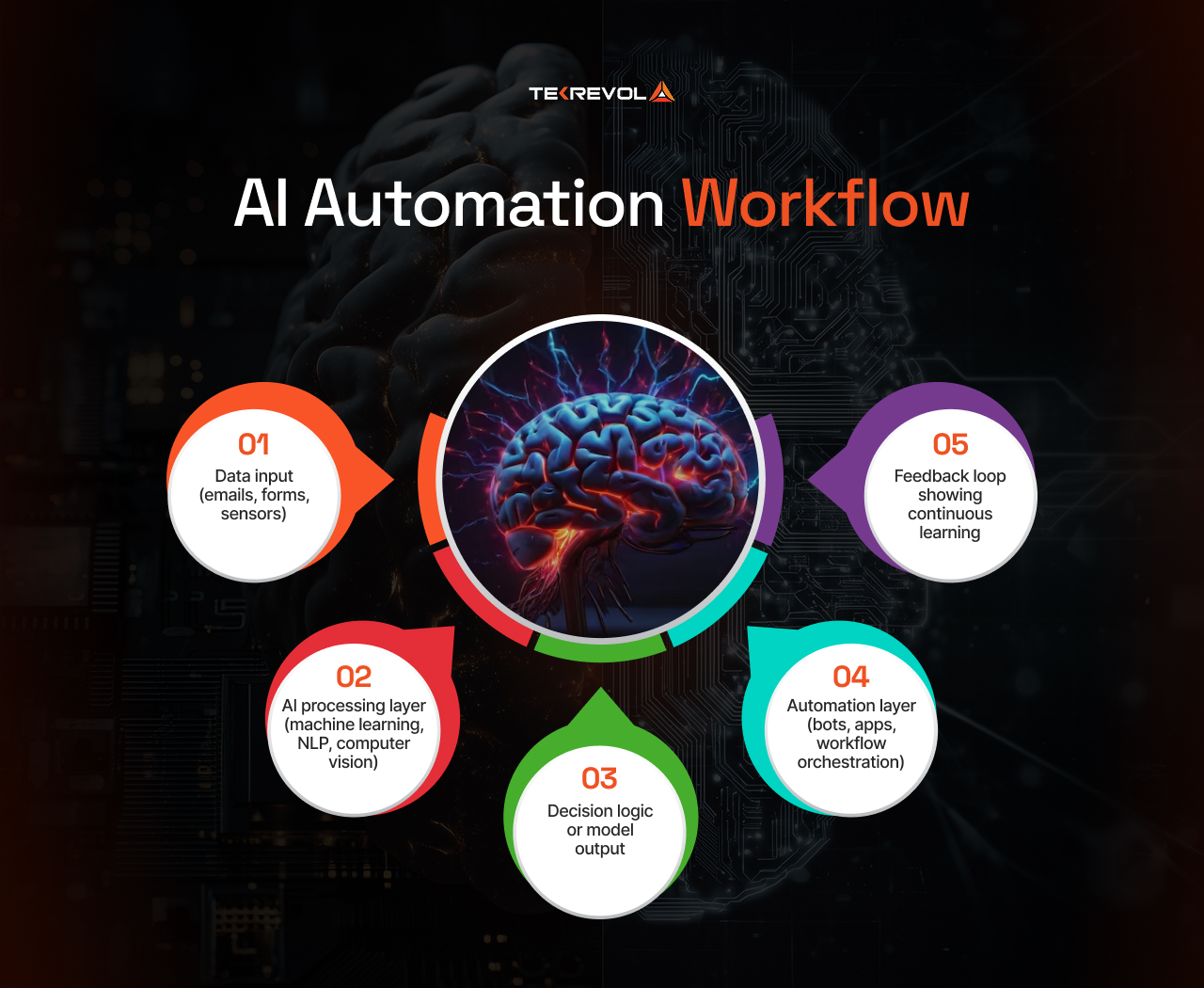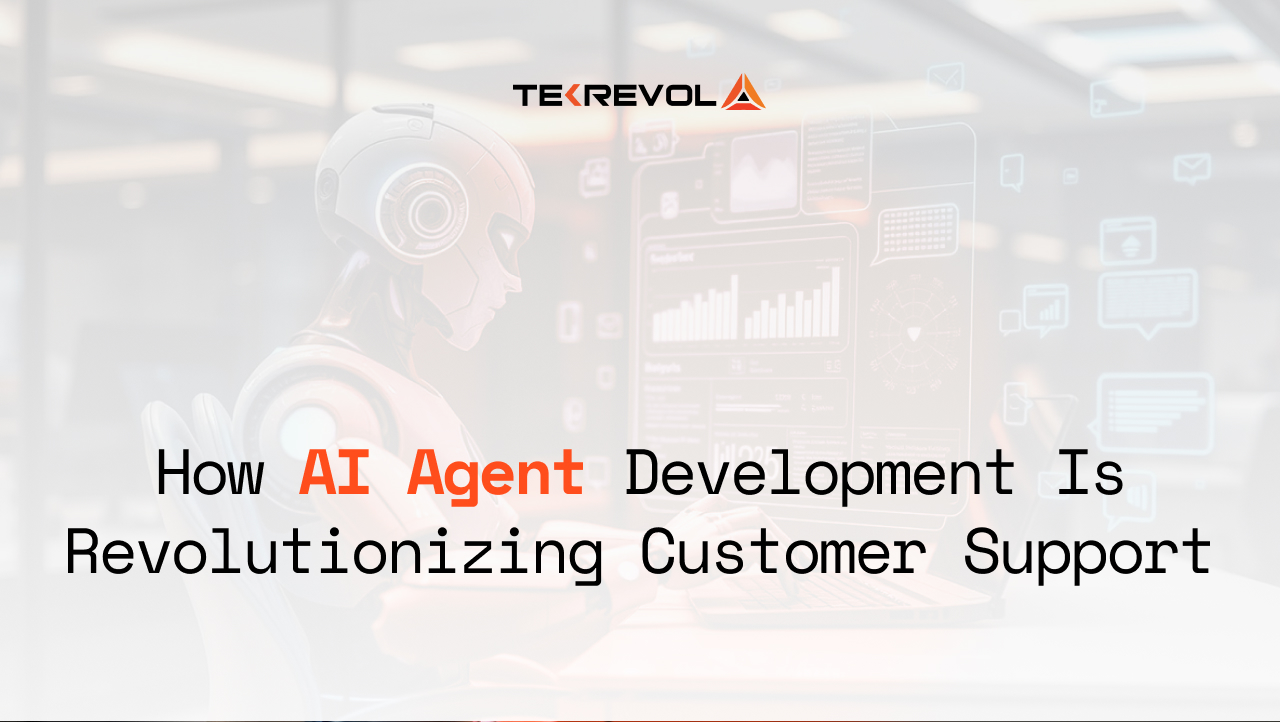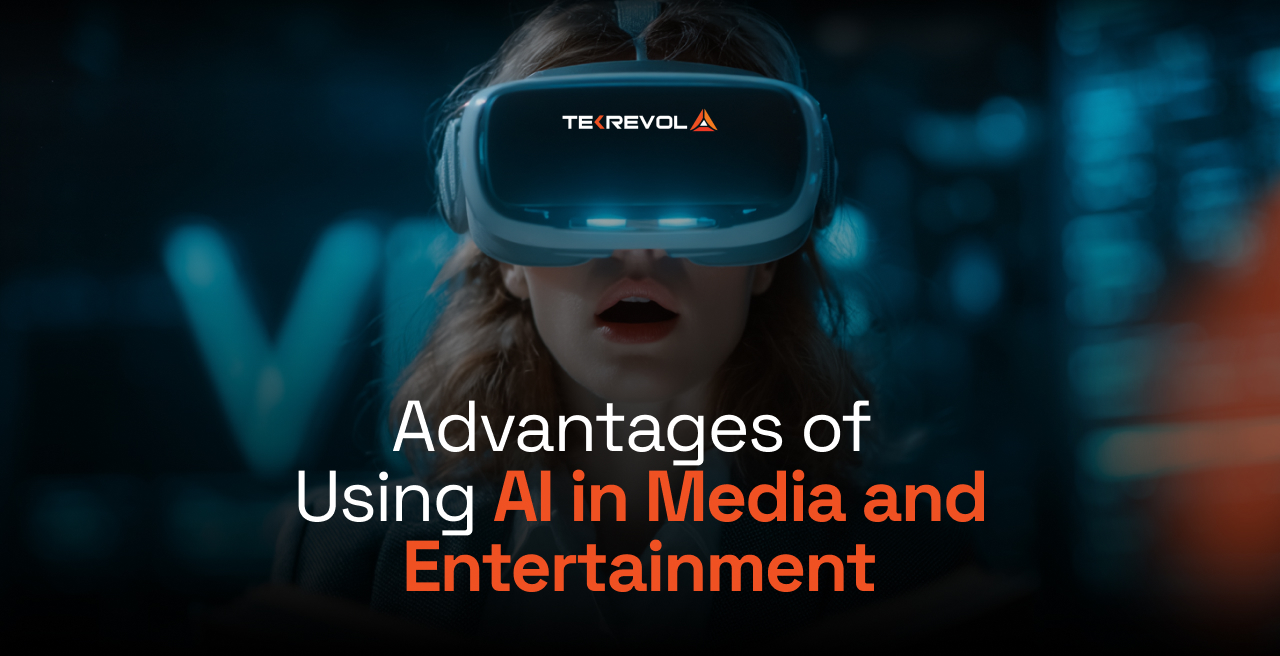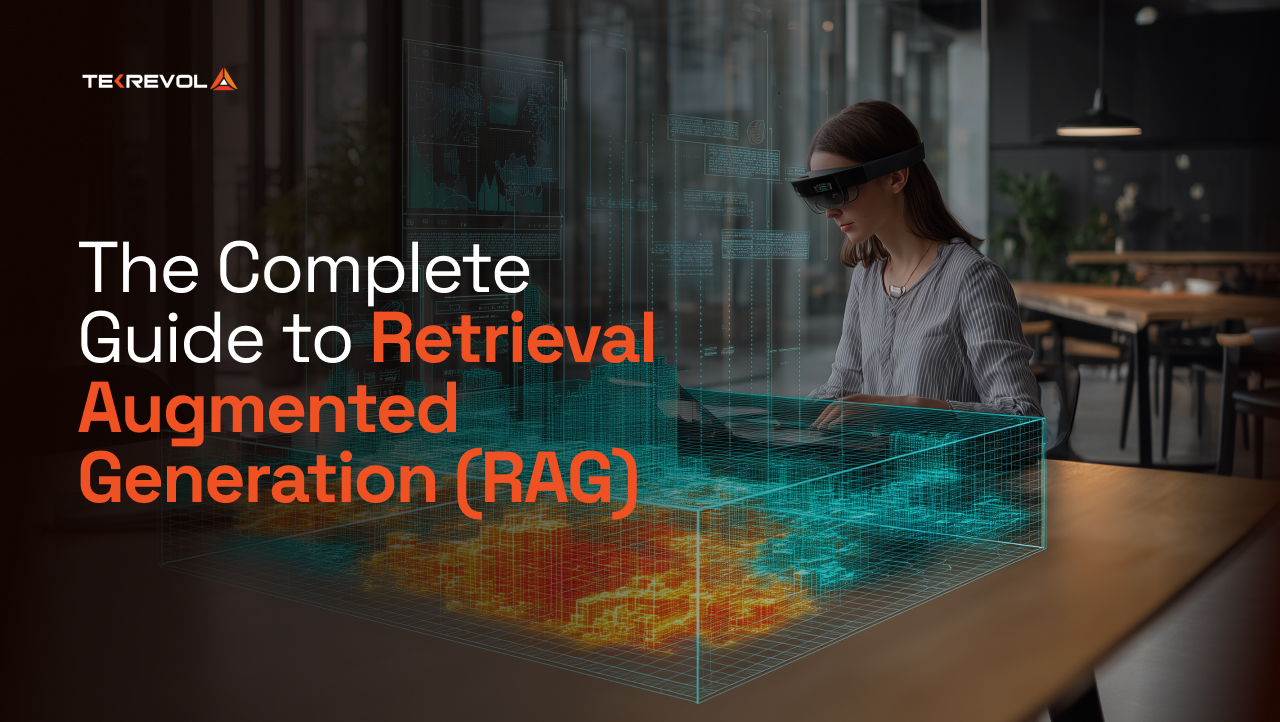Today, business moves too fast for old tools. Manual work and simple software just cannot handle the volume of data we see daily. The best solution lies in AI automation. It introduces intelligence into your workflows that adapts and makes complex decisions without human intervention.
By adopting this approach, you quickly shift from slow work to intelligent high-speed workflows. We move past basic macro recording and enter a world of hybrid human–AI collaboration. The latest wave of generative AI and autonomous agents makes AI automation the most important move for any business aiming to save time and money.
Note that it’s not about letting machines replace people, but giving your best teams self-optimizing tools. Through this guide, we clear all your doubts and show you exactly how to achieve business transformation with artificial intelligence automation.
What Is AI Automation?
AI automation is simply the ability to finish complex tasks or whole business processes automatically using smart technology. It means applying artificial intelligence to automate activities that have always needed human skills like learning, judging, or sensing.
Here, it is imperative to know that AI automation differs from traditional automation. Older methods use rule-based logic and rigid steps. The AI automation definition is much broader. AI in automation incorporates machine learning development and natural language processing, along with computer vision, to handle exceptions and unstructured data.
It adapts the workflow as it goes. Combining AI with Robotic Process Automation or RPA creates powerful end-to-end solutions. These replace simple robots with sophisticated agents that teach themselves.
Stop wasting hours on repetitive work.
Partner with RevAI to experience AI automation workflows that adapt over time.
Talk to Us NowAI vs Automation: What’s the Difference
Many confuse automation with artificial intelligence. However, both differ greatly. Understanding the difference between automation and artificial intelligence is the first step toward smart adoption.
Automation is a follower. It runs pre-defined rules or clear sets of instructions. It needs clear instructions and cannot handle unexpected input. If the input changes, the script fails.
Artificial intelligence provides the intelligence learning and reasoning layer. It provides the ability to reason and to make judgments. AI uses smart algorithms to see patterns in data and then makes a prediction or a decision.
When you blend AI and automation, the resulting system becomes truly adaptable. Automation carries out the physical task. AI decides what the task should be or how to handle a variable that was not planned for.
How AI Automation Works?
The operation of AI automation is a seamless 3-step process built on a continuous feedback loop. It transforms raw data into high-value executed actions.

- The system ingests data from various sources. This includes text, images, audio, and real-time operational metrics. Technologies like natural language processing or NLP and computer vision extract meaning from this unstructured data.
- This meaningful data goes to a machine learning model, which acts as a brain. It makes predictions, sorts information, or classifies things based on its prior training.
- The result from the model triggers the automation pipeline. An execution engine takes the decision and immediately carries out the required task, such as updating a customer record or rerouting a faulty product.
This entire cycle, from input to action, defines the power of artificial intelligence automation.
Key Components of AI Automation Systems
Successful AI automation needs a strong set of tools that work together as a single unit. You must understand these pieces to plan your strategy correctly. The base of AI in automation relies on these core components working in harmony.
- Automation Bots: These digital workers run on an RPA platform and act as the hands of the system. They perform the physical clicking and typing inside your software.
- Intelligence Engines: Specialized models like NLP engines handle text analysis, and OCR extracts data from various images or documents.
- Machine Learning Models. The system also leverages specialized ML development models for predictive tasks. These are the brains that categorize data or identify complex patterns needed for decisions.
- LLM Orchestration: Modern solutions use LLM orchestration frameworks to manage inputs and outputs for large language models. These models handle complex reasoning and content generation.
- Data Pipelines and AI APIs: These connect all the pieces, ensuring data flows smoothly with your existing enterprise systems like CRM and ERP software.
What Are The Benefits of AI Automation for Businesses
The integration of AI and automation delivers measurable and transformative advantages far beyond simple incremental gains that justify investment. These are not abstract benefits; they are verifiable performance indicators.
Cost Reduction
Cost reduction is the most immediate win. Automating repetitive tasks eliminates labor costs and the potential for human error. According to McKinsey & Company, clients achieve 60–70% cost savings within specific high-volume processes like invoice handling through AI automation.
Handling of Unstructured Data
AI business automation is great at handling unstructured data. AI categorizes and extracts information turning previously unusable data into actionable insight.
Improved Overall Productivity
Systems work 24/7, instantly removing bottlenecks from your operations. Productivity improvement often hits a 3× increase because tasks are completed in minutes instead of hours.
Better Accuracy in Decision-Making
AI models can review far more data than any human. They provide deeper insight for taking immediate action. The combination of automation and AI leads to 5–99% accuracy improvements in data extraction and classification tasks.
The above benefits are the direct result of using AI agents for workflow automation. These intelligent systems continuously improve themselves. Focusing on speed and accuracy gives your business an immediate edge over the competition.
AI Automation Examples Across Different Industries
The versatility of automation using AI allows for deep transformation across nearly every business sector. Adoption is driven by unique industry needs and pain points.
Finance and Banking
In the finance sector, smart systems automatically handle compliance checks and detect fraud. They quickly analyze mountains of transaction data to flag odd patterns that humans might miss.
Human Resources and Talent Acquisition
HR automation manages resume screening and initial candidate communication. This greatly speeds up the time it takes to hire new people and reduces administrative load.
Healthcare
AI automation apps for healthcare services are equally crucial. Systems manage patient intake schedules and process complex medical billing. This removes administrative tasks and lets doctors and nurses focus fully on patient care.
Supply Chain and Logistics
Another AI automation example is supply chain management. Predictive models use live data to guess future demand. They automate inventory restock orders to prevent expensive product shortages.
Customer Service Operations
The latest research finds that artificial intelligence automation powers customer service chatbots to resolve up to 80% of routine queries instantly. This provides 24/7 support and only escalates complex problems to human agents.
Administration
The use of intelligent document processing (IDP) is also widespread. This technique handles everything from legal contracts to customer onboarding forms. It is essential for ensuring compliance efficiency across regulated industries.
Find the ideal fit for your industry!
RevAI helps businesses map the perfect AI automation strategy for their sector.
Start Your Assessment Today.How to Implement AI Automation in Your Organization
To implement AI automation successfully, you require a structured plan that focuses on people, process, and technology in equal measure. Because it is a journey, not a single project.
1) Identify Repetitive Workflows
Look for processes that follow the same steps daily. Tasks like data entry or form handling are ideal. Automating these first brings quick results and proof of value.
2) Map the Data Flow
Map how information moves through each step. Check how systems exchange information and where delays happen. This helps define where AI and automation will execute better.
3) Choose the Right Tools
Select platforms that match your team’s skills and data needs. Low-code tools or a reliable AI automation platform let you scale easily. Confirm security and integration support.
4) Run a Pilot Project
Start small with one workflow. Measure performance and accuracy improvements. Use what you learn to refine before scaling across departments.
5) Integrate With Existing Systems
Connect automation tools through secure APIs. Make sure data moves smoothly between apps and teams. Consistent integration reduces errors and boosts efficiency.
6) Train and Support Your Team
Explain how the system works and why it helps. Encourage collaboration between AI tools and staff. Training builds trust and improves results.
7) Track and Improve Continuously
Monitor performance with clear KPIs like cost and accuracy. Update models as data grows and processes change. Continuous tracking keeps automation useful and reliable.
8) Scale and Govern Responsibly
Expand automation where it adds real value. Create a simple AI governance framework and rules for oversight and data governance. Responsible scaling protects trust and supports long-term success.
For organizations looking to move from concept to execution, connecting with specialist AI development companies is often the fastest path to results.
Criteria for Choosing the Right AI Automation Platform
Selecting the right AI automation tools is critical for the long-term success of your initiatives. The platform you choose determines scalability and integration capability.
- Evaluate platforms based on their ability to handle API integration seamlessly, connecting with existing ERP and CRM systems.
- Scalability is non-negotiable. Ensure the platform can handle increasing volumes and complexity as your business grows.
- Lastly, prioritize compliance. Look for certifications like SOC 2, which confirm adherence to stringent security and availability standards.
A well-chosen AI automation platform simplifies deployment and maximizes the return on your investment. Modern solutions often center on an RPA platform combined with low-code tools to build and modify workflows without deep coding skills.
Challenges And Risks in AI Automation
Despite the immense opportunities, the responsible deployment of artificial intelligence automation requires a clear understanding and mitigation of potential challenges. Ignoring these risks harms trust and adoption.
The biggest danger is AI bias. If biased data is used to train the system, then automated decisions will repeat and even increase that unfairness. You must constantly work on ensuring data quality and diversity.
Another common issue is explainability. Many complex AI models do not know why they made a certain decision. This lack of transparency causes problems for audits and regulatory rules.
Also, beware of model drift. Over time, real facts change, making the original model inaccurate. This requires expensive retraining.
Human oversight is essential for effective and ethical automation. AI supports workers but should not replace judgment. Understanding these AI adoption challenges early helps build safer systems.
The Future of AI Automation
The next wave of AI automation involves systems that act as autonomous AI agents. Autonomous AI agents do not wait for the next step. They set their own goals and navigate complexity without human intervention. This allows for continuous learning systems that constantly improve performance.
Similarly, Generative AI shows us new possibilities for business operations. It can now create dynamic code for entire test datasets and marketing campaign outlines. Generative AI automates creative strategy tasks that previously needed high-level human input.
The future of AI and automation is all about smart LLM orchestration. Multiple agents will work together like a specialized team. Imagine one agent finding the data and a second executing a change automatically.
The development of these autonomous systems and advanced AI agents for workflow automation is paving the way for hyper-efficient operations.
Conclusion
AI automation is not a luxury but a fundamental necessity for modern business viability. It provides a definitive competitive edge through dramatic improvements in speed, cost, and accuracy.
You must move past pilot projects to full-scale deployment to reap the benefits of generative AI workflows and agentic systems. To begin your journey and secure your future in this new era, conduct a thorough AI readiness assessment with an AI automation agency.
At RevAI, we enable organizations to adopt artificial intelligence and automation that supports real progress. Given our wide range of ge experience, we assist you in transforming your most complex operations into highly efficient and intelligent workflows.
Bring Intelligent Automation into Your Work.
Connect with our experts to deploy a high-impact AI solution for sustained business growth.
Claim Your Free Strategy Now



